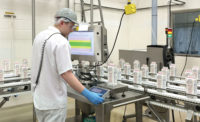
As an initial part of the error-proofing process, Donnelly shares scientific research with its employees to show why mistakes happen and then begins to examine jobs for opportunities to reduce error. Source: Donnelly Custom Manufacturing
Companies have increasingly come to rely on lean manufacturing practices to improve efficiencies in their operations. Yet, without ongoing initiatives, such practices can fall short-particularly in terms of mitigating human error.
Human inspection of parts is often not completely effective. Companies are challenged not just to catch the defects caused by mistakes employees make, but to prevent them from occurring in the first place. According to 2010’sQuality Handbook, Sixth Edition: The Complete Guide to Performance Excellence, 100% human inspection of parts is only about 80% effective.
The challenge for companies, then, is not to catch the defects caused by mistakes employees make, but rather to prevent them from occurring in the first place. Error proofing, a lean technique used by Donnelly Custom Manufacturing Co. (Alexandria, MN), has proven effective in doing just that. The company specializes in short-run injection molding of complex thermoplastics for industrial original equipment manufacturers (OEMs) who sell end-products in lower unit volumes.
Unlike common mistake-proofing techniques that focus on the design phase or the manufacturing processes, Donnelly’s error-proofing methodology focuses on the people, particularly on the mindset needed to implement plant-wide error-proofing techniques. It teaches employees how to take preventative measures that decrease the defects caused by errors.
The Whys and Hows of Error Proofing
Because of the complexity of its business, Donnelly continually seeks out technology advancements and new strategies to improve its productivity and quality. Still, the company faces the inevitable challenges of human error.For that reason, Donnelly chose to apply lessons it learned from the Training Within Industry (TWI) Institute, a program that teaches employees how to improve interoffice relations, problem solving and accuracy. Donnelly created and implemented an error-proofing workshop where employees brought in workplace problems they had encountered that could be addressed with error proofing.
Much like TWI, which prepares supervisors to train employees to solve problems, Donnelly’s error proofing teaches employees to be problem identifiers and solvers.
The first step in the error-proofing process is to help employees establish the right mindset about making mistakes. Donnelly helped employees understand their own weaknesses by educating them about human behavior. Donnelly shared a 2008 study from researchers at the University of Bergen, Norway and the behavioral neuroscience department at Georgia State University that explains that human error is the result of periodic, minor glitches in the brain. When recording brainwaves, scientists can detect these glitches and accurately predict mistakes up to 30 seconds before they happen. Presenting such material to employees is intended to help them approach the error-proofing process with understanding.
When everyone is on the same page, employees must then examine defects caused by mistakes to isolate problems and develop potential solutions. Together, employees brainstorm ideas and rank each potential solution according to the speed, complexity and cost of implementing it, as well as its anticipated effectiveness.
Finally, employees evaluate the solutions and provide their cost/benefit recommendations to customers, who select the one that best meets their needs. Donnelly employees then apply the chosen countermeasure to rectify the mistake. The goal is to determine and select the easiest, lowest cost and most effective solution. Periodic audits help ensure that the countermeasures are effective and enduring.
Real Solutions, Real Problems
Donnelly originally established its error-proofing workshop to address quality issues that occurred with one of its longtime customers. Close analysis pointed out a common cause: mistakes due to human error. Applying the new error-proofing process to several of this customer’s jobs reduced parts rejection associated with human error by 75% year-over-year and reduced parts-per-million defect measures by two-thirds.Since then, Donnelly has continued to implement error proofing for other customers in multiple jobs. One recent success involved a mold requiring multiple hand-loaded inserts. Two mistakes were occurring in the process: employees periodically forgot to load inserts into their molds, and they occasionally placed inserts in backwards.
Together, a team of employees identified 12 different solutions to the problem and ranked them according to cost, speed of implementation and potential effectiveness. The result? Donnelly, in conjunction with the customer, opted to put sensors in the mold that could detect if the insert was in place and would stop the press if it was absent.
While this solution required some investment on the part of the customer, it eliminated the risk of a more costly part failure later.
Secondly, to prevent the insert from being placed in the mold backwards, Donnelly designed and built the pickouts to hold the inserts so that they could only be placed into the mold in the correct direction.
The company also has implemented periodic audits to ensure the countermeasure is being used properly and to measure the success of the solutions. Thus far, the audits indicate the solution has been 100% effective.
While error proofing takes time to implement, the benefits to Donnelly’s productivity and quality are well worth the effort. Error proofing empowers employees to use their knowledge, experience and creativity.
At its core value, error proofing encourages employees to do their best and eliminates barriers that may otherwise prevent them from taking pride in the work they do. It also builds a sense of trust, encouraging teamwork and respect. The end result is employees who are more committed and motivated, and make a better quality product.
TWI Institute
Liverpool, NY
(315) 412-0303
twi-insitute.com
